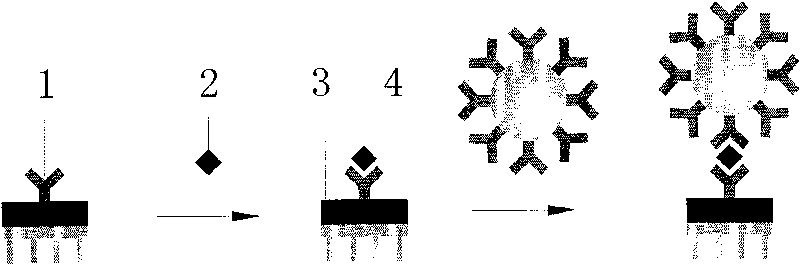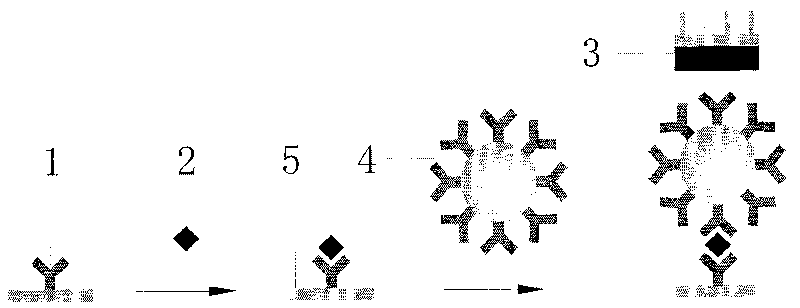Magnetic immunity detection method
An immunodetection method and magnetic technology, which can be used in measurement devices, instruments, scientific instruments, etc., can solve the problems of complex and bulky microplate readers, cumbersome detection steps, and expensive enzymes, and achieve portability, detection sensitivity and accuracy. The effect of improving and speeding up detection
- Summary
- Abstract
- Description
- Claims
- Application Information
AI Technical Summary
Problems solved by technology
Method used
Image
Examples
Embodiment 1
[0051] The hepatitis C antibody is coupled to the surface aminated magnetic methyl methacrylate microsphere in advance, and the hepatitis C antibody is also coupled to the inner surface of the microwell plate. Add 50uL serum samples containing hepatitis C antigen at a certain concentration into the microwell plate, react at 37°C for 5 minutes, wash 5 times with 0.02MPBST (Tween20, 0.5%), and wash away the hepatitis C antigen that does not react with the hepatitis C antibody on the microwell plate. Add 20 uL of magnetic methyl methacrylate microsphere solution (concentration: 35mg / mL) coupled with hepatitis C antibody, react at 37°C for 5min, wash 5 times with 0.02MPBST (Tween20, 0.5%), and wash away the microwell plate bound magnetic microspheres. Extend the magnetic head of the giant magnetoresistance biosensor developed by Sun Yat-sen University into the microwell plate, and determine the presence and concentration of magnetic microspheres on the surface of the microwell pla...
Embodiment 2
[0053]The hepatitis A antibody is coupled to the surface aminated magnetic methyl acrylate microsphere in advance, and the hepatitis A antibody is also coupled to the magnetoresistance film surface of the tunnel magnetoresistance sensor. Take 3 drops (about 0.9uL) of a certain concentration of serum samples containing hepatitis A antigen with a micro-sampler and drop them on the surface of the sensor magnetoresistance film, react at 37°C for 5 minutes, wash 5 times with 0.02MPBST (Tween20, 0.5%), wash Remove the hepatitis A antigen that has not reacted with the hepatitis A antibody on the membrane surface. Then take 3 drops (about 0.9uL) of magnetic methyl acrylate microsphere solution (concentration: 30mg / mL) with a micro-sampler, add it dropwise on the surface of the magnetic resistance film of the sensor, react at 37°C for 5min, and use 0.02MPBST (Tween20, 0.5%) was washed 5 times to wash away the magnetic microspheres not coupled to the hepatitis A antibody on the membrane...
Embodiment 3
[0055] Hepatitis B antibody was coupled to the surface aminated magnetic polystyrene microspheres in advance, and hepatitis B antibody was also coupled to the surface of the giant magnetoresistive biosensor magnetic head developed by Sun Yat-sen University. Add 50uL of a certain concentration of serum containing hepatitis B antigen to 20uL of magnetic polystyrene microsphere solution coupled with hepatitis B antibody (concentration: 40.5mg / mL), react at 37°C for 5min, and magnetically separate off the surface of the magnetic microsphere that is not connected to the surface of the magnetic microsphere. HBV antigen for HBV antibody response. The magnetic head of the magnetoresistive sensor was inserted into the magnetic microsphere solution, reacted at 37°C for 5 minutes, washed 5 times with 0.02MPBST (Tween20, 0.5%), and the magnetic microspheres not coupled to the hepatitis C antibody on the surface of the magnetic head were washed away. The existence and concentration of the ...
PUM
 Login to View More
Login to View More Abstract
Description
Claims
Application Information
 Login to View More
Login to View More - R&D
- Intellectual Property
- Life Sciences
- Materials
- Tech Scout
- Unparalleled Data Quality
- Higher Quality Content
- 60% Fewer Hallucinations
Browse by: Latest US Patents, China's latest patents, Technical Efficacy Thesaurus, Application Domain, Technology Topic, Popular Technical Reports.
© 2025 PatSnap. All rights reserved.Legal|Privacy policy|Modern Slavery Act Transparency Statement|Sitemap|About US| Contact US: help@patsnap.com



